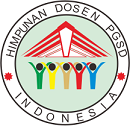PENGEMBANGAN PERANGKAT PEMBELAJARAN MENGGUNAKAN MODEL PEMBELAJARAN PROBLEM BASED LEARNING BERBASIS TPACK DALAM MENINGKATKAN LITERASI DIGITAL DAN SELF - EFFICACY SISWA
DOI:
https://doi.org/10.24114/sejpgsd.v15i2.66272Keywords:
Digital Literacy, TPACK, Self EfficacyAbstract
This study aims to develop learning devices using the Problem-Based Learning (PBL) model based on Technological, Pedagogical, and Content Knowledge (TPACK) to enhance students' digital literacy and self-efficacy in a valid, practical, and effective manner. The developed learning devices consist of lesson plans (RPP) and student worksheets (LKPD). This development research employs the IDI (Instructional Development Institute) model, which includes three stages: 1. Define, 2. Design, 3. Develop. The research instruments include validation sheets, practicality assessment sheets by teachers and students, learning implementation observation sheets, and test instruments for digital literacy and self-efficacy. The trial subjects are teachers and sixth-grade students of SD Swasta Kartini Handayani Pematangsiantar. The research data were analyzed to determine the quality category of the developed learning devices. The data analysis is divided into three criteria:1. Validity analysis of learning devices, 2. Practicality analysis of learning devices, 3. Effectiveness analysis of learning devices. The learning devices are considered valid if expert assessments of the lesson plans (RPP) and student worksheets (LKPD) meet the "good" criteria, and the digital literacy and self-efficacy test instruments are declared valid based on expert judgment. The practicality criteria are met if teachers' and students' assessments fall into the "good" category. Meanwhile, the learning devices are considered effective if the learning mastery exceeds 60%. Data collection was conducted through observations, tests, and interviews. The research results indicate that the developed learning devices are valid, practical, and effective in improving students' digital literacy and self-efficacy. This study contributes to innovative learning strategies that support student-centered education in the digital era.References
Agustin, N. A. F., & Azmy, B. (2022). Implementasi TPACK Terhadap Literasi Siswa Sekolah Dasar: Studi Literatur. SNHRP, 817-822.
Bandura, A. (1993) ., Perceived Self – efficacy in Cognitive Development and Functioning, Educational Psychologist, 28, (2), 117-148
Gunawan, D., Sutrisno, S., & Muslim, M. (2020). Pengembangan Perangkat Pembelajaran Matematika Berdasarkan TPACK untuk Meningkatkan Kemampuan Berpikir Kritis. Jurnal Pendidikan Matematika, 11(2), 249-261.
Kamdi, W. (2017). Model-model Pembelajaran Inovatif. Malang: Universitas Negeri Malang.
Liu, X., & Koirala, H. (2019). The Effect of Mathematics Achievement of High School Students. Northeastern Education Research Association (NERA) Conference Proceedings, 30, 1-13.
Sari, D. P., Syahputra, E., & Surya, E. (2018). An analysis of spatial ability and self-efficacy of students in cooperative learning by using jigsaw at smas muhammadiyah 8 kisaran. American Journal of Educational Research, 6(8), 1238-1244.
Suyamto, J., Masykuri, M., & Sarwanto, S. (2020). Analisis kemampuan tpack (technolgical, pedagogical, and content, knowledge) guru biologi sma dalam menyusun perangkat pembelajaran materi sistem peredaran darah. Inkuiri: Jurnal Pendidikan IPA, 9(1), 44-53.
Rusman. (2016). Model-model Pembelajaran Mengembangkan Profesionalisme Guru. Jakarta: Raja Grafindo Persada.
Widoyoko, E. P. (2016). Teknik Penyusunan Instrumen Penelitian. Yogyakarta: Pustaka Belajar.
Additional Files
Published
Issue
Section
License
Copyright (c) 2025 SCHOOL EDUCATION JOURNAL PGSD FIP UNIMED

This work is licensed under a Creative Commons Attribution-ShareAlike 4.0 International License.
Authors whose manuscripts are approved are approved as follows:
- The publication rights for all journal manuscript materials published/published on the SEJ (School Education Journal) E-Journal site are held by the editorial board with the author's knowledge (moral rights remain with the manuscript authors).
- The formal legal requirements for accessing this electronic digital journal article are subject to the terms of the Creative Commons Attribution-ShareAlike (CC BY-SA 4.0) license, which means that E-Journal SEJ (School Education Journal) has the right to store, transfer media/format, manage in the form of a database, maintain, and publish articles without asking permission from the author as long as the author's name remains as the copyright owner.
- Manuscripts published/published electronically are open access for educational, research, and library purposes.













